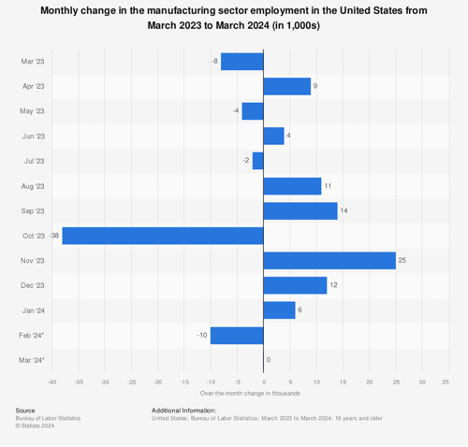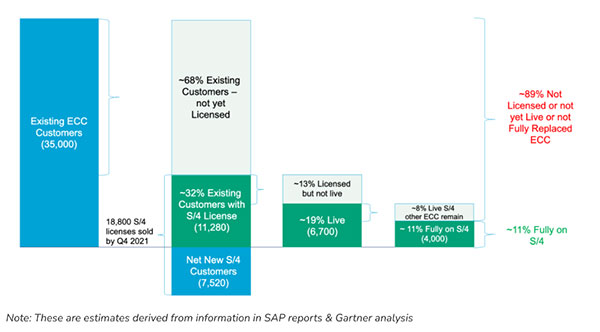Manufacturing’s skills gap has worsened, creating threats to future growth objectives. It’s time we examined how the skills shortage can be circumvented.
Manufacturers contend with processes beyond most digitally-native businesses. Complex supply chains require constant management, production necessitates vigorous due diligence, quality control, and reporting, and dynamic consumer preferences demand the ability to react quickly to market changes.
Regardless, the sector has always pushed the envelope in design, functionality, and production. Smarter ways of operating, upgrading machinery, and incorporating new materials are cornerstone examples. Yet, as technology continues to reshape global business, a tipping point has been reached between new technologies, available skills, and unoptimised back-end systems. This misalignment is dampening the sector’s growth potential – a loss that has been forecast to cost US manufacturers GDP $2.5 trillion by 2028.

The manufacturing skills gap is well documented. Deloitte states 83% of manufacturers see attracting and retaining quality talent as a top challenge. In the US, the gap is predicted to reach 2.1 million roles by 2030 and Wiley reports that 69% of US businesses are facing a skills gap as of 2023, up from 55% in 2021. Equally, 79% of US CEOs are concerned about a shortage of key skills. As manufacturing is an increasingly tech-led industry, it could be defined as an IT problem, however, the gap here is similarly daunting.
Forbes found 93% of UK businesses acknowledged an IT skills gap, while Microsoft revealed 69% of decision-makers feel their organization suffers from a lack of digital skills. Even nations famed for their manufacturing are struggling to solve their technology skills gap; McKinsey reports 700,000 vacant tech jobs in Germany, forecast to increase another 80,000 by 2026.
Looking at US manufacturing employment over the last year, we see a scattered trend, with data suggesting a plugging of existing gaps rather than strategic, increased employment.

If we consider manufacturing and IT skills gaps as symbiotic, there are several reasons why the industry’s attempts to bridge them have been unsuccessful.
The first is that technological innovation is skyrocketing; 42% of UK businesses cited fast-paced innovation as the primary restriction holding them back from bridging skills gaps. Others identify a deeper-rooted problem, with 37% citing a lack of accessible education and training, a dynamic greater in the US, as education fees are higher and college admission competition fierce.
There is also the sheer competitiveness of today’s job market to contend with. Scarce talent and the increasingly difficult challenge of retaining and recruiting skilled individuals means 35% of businesses are struggling in this regard. Additionally, many of the skilled manufacturing professionals who started their careers 30 years ago are now nearing retirement, but a lack of young talent entering the field leaves an alarming void.
All of these factors are responsible for a widening skills gap that now looks like an uphill battle to try and close.
Regardless of how shiny the machines are on the factory line, the true power behind manufacturing lies in back-end systems capable of handling complex operations. Without the necessary skills to manage these platforms, digital transformation will suffer; the migration to SAP’s S/4HANA is an excellent example of this risk.
In 2020, SAP set a deadline of 2027 for migration to S/4HANA, a re-platforming (in-memory) transformation to vital SAP systems that have helped businesses operate and make internal changes for the best part of three decades. The transition promises significant upgrades, such as access to SAP’s AI offerings such as SAP Joule. However, we’re now halfway toward that deadline, yet only 11% of SAP customers had fully migrated by 2022. For Q1 2024, other research suggests uptake in S/4HANA has risen to 34%.

A lack of skilled resources is the primary reason for this lack of progress. Not only are businesses rushing to complete their S/4HANA journeys by 2027, but they’re simultaneously losing out on the ease of deployment, efficient UX, and faster insights S/4 is providing to competitors who are further along their migration journey, and who have fewer skills concerns. Without proper management of core systems, the rest of a business’s operations cannot fire on all cylinders.
However, beyond sourcing talent, there are steps manufacturers can take to reduce the deficit.
Emerging technologies contribute to the widening skills gap but can be leveraged to reduce the challenge. Chiefly, automation can be utilised.
Manufacturers implementing automated processes can remove considerable burden from workforces encumbered by manual tech-based tasks, taking on a significant portion of the ‘heavy lifting’ required by technology teams.
In doing so, more resources can be directed toward creating the optimal products. Equally, automation reduces the dynamic of workers ‘jumping in’ on tasks they are not fully qualified for, reducing the risk of human error associated with an ‘all hands on deck’ approach.
These benefits are not lost on leaders at the enterprise level. Harvard Business Review research from 2023 states more than 90% of workers said automation solutions increased productivity, and 85% said these tools boosted collaboration across teams. In addition, almost 90% stated they trust automation to perform tasks without error and help them make decisions faster.
While automation is not a silver bullet for the manufacturing skills gap, it does provide a method of allowing skilled workers to focus less on managing time-intensive technological processes, and more on ensuring their factories are outputting the best quality products possible.
As an industry, we must learn that the technology at our disposal is only as good as the talented employees we have to harness it. In most cases, automation should be the first port of call when tackling the manual task workload to take on the heavy lifting of unnecessarily manual tasks, then deploy the latest technology across the production line. There’s a long way to go in bridging the manufacturing skills gap, and widespread acknowledgment of how technology can mitigate these shortcomings is the first step toward removing the heavy lifting on scarce, time-poor talent.

David Lees has 20+ years helping some of the world’s largest brands with ERP solutions, having led the team at P&G for over a decade. He’s now CTO at Basis Technologies, the company that has helped digitally transform core systems for SAP clientele. A specialist in digital transformation and change management, David has helped some of the world’s largest brands such as Honda, 3M, John Deere, Ericsson, Vistaprint, with their digital transformation journeys.
Scott Ellyson, CEO of East West Manufacturing, brings decades of global manufacturing and supply chain leadership to the conversation. In this episode, he shares practical insights on scaling operations, navigating complexity, and building resilient manufacturing networks in an increasingly connected world.